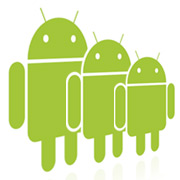
The Internet is abuzz with news that Google has teamed up with food giant Nestle to name the next version of Android after the latter’s famous chocolate bar — KitKat — rather than continue its tradition of nonbranded nomenclature with the name “Key Lime Pie.”

KitKat will be Android 4.4 and not Android 5 as some expected.
“We were contacted by Google in November 2012 and quickly afterwards decided to team up with them on this exciting partnership,” Nestle spokesperson Nina Caren Kruchten told the E-Commerce Times.
Some Guys Have All the Luck
The team-up with Nestle is likely a happy accident, Daniel Ladik, an associate professor of marketing at Seton Hall University, told the E-Commerce Times.
“The software engineers [probably] needed a codeword for the project, and one of them was inspired by a trip to the vending machine to get a late-night snack,” Ladik surmised.
He might be right on the money.
“KitKats [have been] a favorite among the Google Android team since the early days of Android,” Nestle’s Kruchten said.
Sweets For My (Android) Sweet
Both the Android and KitKat brands have worldwide recognition.
Android has more than 75 percent of the global smartphone OS market now, though this will fall to just over 68 percent by 2017, IDC predicted on Wednesday.
KitKat “is one of the world’s top 10 fast-moving consumer goods brands in social media in terms of fan numbers and engagement,” Nestle’s Kruchten said. “We continue to build on its strong digital presence with interactive, creative branding campaigns such as the one with Google.”
The gain is all for KitKat, Seton University’s Ladik commented.
“I see little gain on the Google side of the equation,” Ladik explained. “Android is a huge brand worldwide, both in market share and revenue, [and] the gain is all for KitKat. I believe that Nestle saw the benefit in this and let Google use the trademarked brand. On the jetpacks of Google, the brand will get a wind at its back that no marketing campaign could ever supply.”
Android’s tie-in with KitKat is a marketing move that is “distinctly different and refreshing compared to the ‘We’ll spend whatever it takes to be innovative’ or ‘Honestly, this will change your effing life’ exercises that are so common in high tech,” Charles King, principal analyst at Pund-IT, remarked.
There is no downside for Nestle, King surmised. “It’s an old and wise company that realizes all PR is good and PR that doesn’t cost you anything is even better.”
Nor is there a downside for Google, which “is apparently big enough, smart enough and successful enough to feel comfortable laughing at itself,” King told the E-Commerce Times.
The Magic of Marketing – or Not
It’s likely that the tie-in will provide a “nice boost” to KitKat sales, Ladik suggested.
“The more the brand gets mentioned, the more it will be top of mind. The more it is top of mind, the more it will be purchased,” Ladik explained.
Chocolate bars are usually an unplanned purchase, so when someone is walking into a convenience store or standing in front of a vending machine, the strongest thought or memory will be the deciding factor in influencing what will get purchased, Ladik pointed out.
“In marketing theory parlance, [the tie-in] becomes a trigger or a heuristic,” Ladik said.
However, “this is the PR equivalent of empty calories — as easily forgotten as it is consumed,” Pund-IT’s King opined.
“Unless Google starts giving away a free box of KitKats with every new Nexus 4 phone, I doubt many people outside the two companies’ employees will remember this a month from now,” King continued. “But toss [that box of KitKats] in along with late-night sales in cannabis-friendly communities like Denver and Seattle, and Google could see a sweet spike in Android adoption.”












































Social Media
See all Social Media